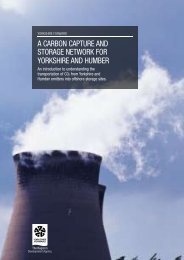Final report for One North East And NEPIC 21/12/10 - The Carbon ...
Final report for One North East And NEPIC 21/12/10 - The Carbon ...
Final report for One North East And NEPIC 21/12/10 - The Carbon ...
You also want an ePaper? Increase the reach of your titles
YUMPU automatically turns print PDFs into web optimized ePapers that Google loves.
<strong>The</strong> case <strong>for</strong> a Tees CCS network<strong>Final</strong> ReportTable 4 identifies the economies of scale or higher capital efficiency of investment in the„Medium‟ network compared to the „Anchor‟ network. Thus <strong>for</strong> an additional up-frontinvestment of £201 m it is possible to increase capacity from 5 to 22 Mt/yr.Assuming a simple cost recovery model, the cost of service <strong>for</strong> users of the network willneed to cover:Capital and operating costs <strong>for</strong> the onshore pipelines.Capital and operating costs <strong>for</strong> the offshore pipeline.Capital, operating and energy costs <strong>for</strong> shoreline compression.<strong>The</strong> costs of financing.Table 4 identifies the cost of service <strong>for</strong> the different CO 2 networks, based on a flat ratecharging model. 673.5.3 CO 2 transport by ship<strong>The</strong> deep-water port provides flexibility in offshore CO 2 transport infrastructure. Assumingexcess pipeline and storage capacity is accessible by pipeline from the Tees Valley, theport facilitates ease of CO 2 import by ship from other regions of the UK and Europe whichmay not have convenient access to safe storage sites 68 .<strong>The</strong> Tees Valley already has a history of ship transport of CO 2 <strong>for</strong> use in the food anddrinks sector. Shipping can be cost competitive with pipelines <strong>for</strong> small volumes. With leadtimes <strong>for</strong> CO 2 ships expected to be two to three years, individual ships can be ordered tomeet demand, which means capacity and utilisation can be matched more closely than <strong>for</strong>pipelines 69 . An analysis of the economics of CO 2 transport by ship was out of the scope ofthe present study.3.5.4 Lead times and phasing of CO 2 transport network economicsLike other investments in low carbon infrastructure, CCS infrastructure development isassociated with long lead times. Even an anchor only CCS system will have a critical pathinvolving several elements, each of which may take one or more years:Storage site evaluationClarification of policy, legal, regulatory and economic conditionsDetailed engineering designPermittingProcurement and financingConstruction (could take three or four years)CommissioningWhilst some of these steps could occur in parallel, even if a decision is made by the publicsector to support CCS in the <strong>North</strong> <strong>East</strong>, it may take between five and seven years <strong>for</strong> ademonstration project to be fully operational. Addition of subsequent projects will be policy67 A range of alternative tariff structures can be modelled.68 <strong>The</strong> proposed Fortum/TVO project intends to transport CO 2 from the Meri Pori coal-fired power plant in Finlandto the <strong>North</strong> Sea by ship, and the use of shipping has been highlighted within the Rotterdam Climate Initiative.69 In the event of non-utilisation, ships can be redeployed elsewhere in the world <strong>for</strong> CO 2 or LPG transport, andthere<strong>for</strong>e present a contrasting risk profile to pipelines where investment is highly specific.26







